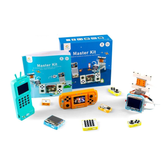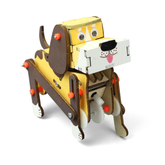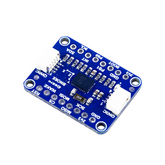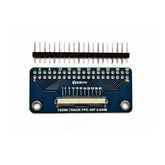-
MCP2515 Can Bus Module Board TJA1050 Receiver SPI for 51 MCU Arm ControllerMCP2515 Can Bus Module Board Controlled Area Network of simple CAN is a bus standard that allows a Microcontroller and its peripheral devices to communicate without the need of a host device or a computer. The MCP2515 CAN bus module is designed with an SPI 51...
- Rs. 93
Rs. 144- Rs. 93
- Unit price
- per
Save Rs. 51 -
USB Type-C Connector Breakout (Female) - 7SemiUSB Type-C Connector Breakout (Female) - 7Semi The 7Semi USB Type-C Connector Breakout (Female) offers a simple and efficient solution for integrating USB-C connectivity into your projects without the need to solder delicate SMD pads. Designed for convenience, this breakout board provides easy access...
- Rs. 34
Rs. 44- Rs. 34
- Unit price
- per
Save Rs. 10 -
AT24C256 I2C EEPROM Memory ModuleAT24C256 I2C EEPROM Memory Module All pins leads out and be marked, the address input and the write-protect pin direct jumper settings on-board pull-up resistor for I2C communications required Onboard 8P-chip carrier, can support AT24C256 series chips Pin power supply, on-board power indicator
- Rs. 54
Rs. 79- Rs. 54
- Unit price
- per
Save Rs. 25 -
W25Q64 NorFlash Storage Module 64MbitW25Q64 NorFlash Storage Module 64Mbit The 64Mbit 8MByte Data Flash module SPI Interface BV/FV solves the problem of insufficient storage space on systems with limited space. When compared to common Serial Flash devices, the 25Q series is very efficient and provides high flexibility and...
- Rs. 66
Rs. 99- Rs. 66
- Unit price
- per
Save Rs. 33 -
ICM-20948 9DoF IMU Breakout Board (MPU-9250 Upgrade) - 7SemiICM-20948 9DoF IMU Breakout Board (MPU-9250 Upgrade) - 7Semi The 7Semi ICM-20948 9DoF IMU Breakout is a compact and versatile motion tracking module designed for applications in smartphones, wearables, and IoT devices. It integrates a 3-axis gyroscope, 3-axis accelerometer, and 3-axis magnetometer, providing comprehensive...
- Rs. 906
Rs. 1,269- Rs. 906
- Unit price
- per
Save Rs. 363 -
USB Type C PCB Male Breakout Board (4 Pin) -7SemiUSB Type C PCB Male Breakout Board (4 Pin) -7Semi The USB Type C PCB Male Breakout Board (4 Pin) - 7Semi is a practical solution for developers and hobbyists seeking easy access to USB Type-C functionality in their projects. It features a straight...
- Rs. 46
Rs. 58- Rs. 46
- Unit price
- per
Save Rs. 12 -
CH340C USB Type C to TTL Serial Converter Breakout Board -7SemiCH340C USB Type C to TTL Serial Converter Breakout Board -7Semi The 7Semi CH340C USB Type-C to TTL Serial Converter Breakout Board by 7semi is a cutting-edge interface tool engineered for seamless device communication. Equipped with a USB-C connector and powered by the advanced...
- Rs. 87
Rs. 129- Rs. 87
- Unit price
- per
Save Rs. 42 -
CH376 USB Host Interface Module Flash Disk Drive RW ModuleCH376 USB Host Interface The "CH376S USB read/write module" has a CH376S chip onboard which does most of the hard work for you. All you have to do is send the module some commands from the Arduino and the CH376S chip will do the...
- Rs. 229
Rs. 498- Rs. 229
- Unit price
- per
Save Rs. 269 -
ADS1115 4-Channel 16bit ADC Breakout Board with PGA I2C -7SemiADS1115 4-Channel 16bit ADC Breakout Board with PGA I2C -7Semi The 7Semi ADS1115 4-Channel 16-bit ADC Breakout Board integrates the high-precision Texas Instruments ADS1115 analog-to-digital converter, featuring a programmable gain amplifier (PGA) for versatile input signal scaling. Designed with an easy-to-use I2C interface, this...
- Rs. 189
Rs. 246- Rs. 189
- Unit price
- per
Save Rs. 57 -
USB 3.1 Type-C Male Breakout Board (24-Pin) - 7SemiUSB 3.1 Type-C Male Breakout Board (24-Pin) - 7Semi The 7Semi USB 3.1 Type-C Male Breakout Board (24-Pin) offers a practical solution for integrating USB-C connectivity into your projects without the need for soldering individual small SMD pads. Featuring a straight plug type 24-pin...
- Rs. 76
Rs. 99- Rs. 76
- Unit price
- per
Save Rs. 23 -
BNO085 9-DOF IMU Orientation Qwiic Fusion Breakout -7SemiBNO085 9-DOF IMU Orientation Qwiic Fusion Breakout -7Semi The 7Semi BNO085 9-DOF IMU Orientation Qwiic Fusion Breakout is a compact and powerful sensor module that combines a 3-axis accelerometer, gyroscope, and magnetometer to provide full 9 degrees of freedom (9-DOF) motion tracking. At its...
- Rs. 2,174
Rs. 2,935- Rs. 2,174
- Unit price
- per
Save Rs. 761 -
SOIC28/SOP28/SO28 TSSOP28/SSOP28 Adapter PCB Board - 7SemiSOIC28/SOP28/SO28 TSSOP28/SSOP28 Adapter PCB Board - 7Semi The 7Semi SOIC28/SOP28/SO28 TSSOP28/SSOP28 Adapter PCB Board is a versatile breakout solution crafted to simplify the use of surface-mount device (SMD) packages in prototyping projects. Designed specifically for SOIC28, SOP28, SO28, TSSOP28 (1.27 mm pitch), and SSOP28...
- Rs. 28
Rs. 34- Rs. 28
- Unit price
- per
Save Rs. 6 -
USB 3.1 PCB Connector Type C Female Breakout Board -7SemiUSB 3.1 PCB Connector Type C Female Breakout Board -7Semi The USB 3.1 PCB Connector Type C Female Breakout Board by 7SEMI is designed to empower developers and makers with easy access to USB Type-C technology. Featuring a robust 24-pin Type-C female connector, this...
- Rs. 89
Rs. 114- Rs. 89
- Unit price
- per
Save Rs. 25 -
BNO086 9-DOF VR IMU Orientation Qwiic Fusion Breakout -7SemiBNO086 9-DOF VR IMU Orientation Qwiic Fusion Breakout -7Semi The 7Semi BNO086 9-DOF VR IMU Orientation Qwiic Fusion Breakout is a compact, high-precision motion sensing solution that integrates a 3-axis accelerometer, gyroscope, and magnetometer into a single board. At its core is a powerful...
- Rs. 2,294
Rs. 2,982- Rs. 2,294
- Unit price
- per
Save Rs. 688 -
UART Mux 4 Channel Breakout Board (SN74LV4052) -7SemiUART Mux 4 Channel Breakout Board (SN74LV4052) -7Semi The 7Semi UART Mux 4 Channel Breakout Board features the SN74LV4052 dual 4-channel analog multiplexer/demultiplexer, allowing seamless switching between multiple UART devices using a single microcontroller UART interface. Designed to operate across a broad voltage range...
- Rs. 265
Rs. 350- Rs. 265
- Unit price
- per
Save Rs. 85 -
MagJack RJ45 Ethernet Connector Breakout Board -7SemiMagJack RJ45 Ethernet Connector Breakout Board -7Semi The 7Semi MagJack RJ45 Ethernet Connector Breakout Board is a robust and user-friendly solution for adding Ethernet connectivity to your electronic projects. Equipped with the high-performance LPJ0011FBNL RJ45 connector and integrated 10/100 Base-T magnetics, this breakout ensures...
- Rs. 149
Rs. 194- Rs. 149
- Unit price
- per
Save Rs. 45 -
CH375B U Disk Read Write Module USB Reader ModuleCH375B U Disk Read Write Module The CH375B U Disk Read Write Module is fully compatible with CH372, CH375. The CH375 firmware has a built in dedicated protocol processing Mass-Storage and can be directly used as the basic unit of reading and writing in sectors USB storage devices....
- Rs. 292
Rs. 440- Rs. 292
- Unit price
- per
Save Rs. 148 -
ADS1262 32bit ADC Module with PGA Breakout -7SemiADS1262 32bit ADC Module with PGA Breakout -7Semi The 7Semi ADS1262 32-bit ADC Module with PGA Breakout is engineered for high-accuracy analog signal conversion, making it ideal for precision applications such as weigh scales, strain gauges, thermocouples, and RTD sensing. At its core is...
- Rs. 2,354
Rs. 3,060- Rs. 2,354
- Unit price
- per
Save Rs. 706 -
0.5mm FFC FPC Connector Breakout Board (40 Pin) -7Semi0.5mm FFC FPC Connector Breakout Board (40 Pin) -7Semi The 7Semi 0.5mm FFC FPC Connector Breakout Board (40 Pin) is a high-precision prototyping tool engineered for seamless integration of flexible flat cables (FFC) and flexible printed circuits (FPC) into your electronic projects. Featuring a...
- Rs. 104
Rs. 135- Rs. 104
- Unit price
- per
Save Rs. 31 -
0.5mm FFC FPC Connector Breakout Board (10 Pin) -7Semi0.5mm FFC FPC Connector Breakout Board (10 Pin) -7Semi The 7Semi 0.5mm FFC FPC Connector Breakout Board (10 Pin) is a powerful prototyping accessory that simplifies your circuit development process. Featuring a reliable 0.5mm pitch, 10-pin FFC/FPC connector securely mounted on a high-quality PCB,...
- Rs. 94
Rs. 120- Rs. 94
- Unit price
- per
Save Rs. 26

Best Price Guarantee

Ready Stock for Bulk Purchase

Dedicated Account Managers

5% GST Benefits for Eligible SEZ and Edu

Technical Support Available

1-Year Manufacturer Warranty




















































